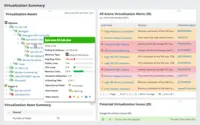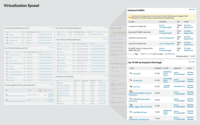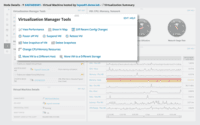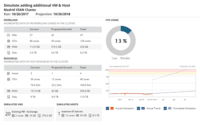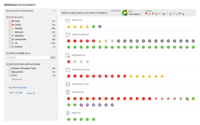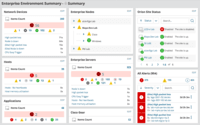Overview
What is SolarWinds Virtualization Manager (VMAN)?
SolarWinds® Virtualization Manager (VMAN) is a tool for monitoring, performance management, capacity planning and optimization for on-premises or cloud-based virtual environments. It also integrates with other SolarWinds products.
A necessity for any virtual environment!
SolarWinds VMAN Easy-to-Use Monitoring Virtual Environment
Single Pane of Glass for Infrastructure Monitoring
Great Alternative Tool to Manage Your VMs
Well suited for monitoring complex hybrid environments
SolarWinds VMAN - A Great Solution for Virtual Infra Management and Monitoring
SolarWinds VMAN is a Solid Product
SolarWinds Virtualization Manager (VMAN), helps do my job and saves me money at the same time.
For effective virtual administration VMAN offers more!!!
SolarWinds VMAN Powerful and Simple VM Monitoring
Wide Area Network Monitoring Tools
One of the best products
So instead of using VROPS and basic vCenter monitoring we using VMAN …
A virtual machine monitoring and management tool that helps you with remediations
Virtualization Manager
What else can be better than VMAN when mostly used Virtualization Vendor got covered
Awards
Products that are considered exceptional by their customers based on a variety of criteria win TrustRadius awards. Learn more about the types of TrustRadius awards to make the best purchase decision. More about TrustRadius Awards
Pricing
What is SolarWinds Virtualization Manager (VMAN)?
SolarWinds® Virtualization Manager (VMAN) is a tool for monitoring, performance management, capacity planning and optimization for on-premises or cloud-based virtual environments. It also integrates with other SolarWinds products.
Entry-level set up fee?
- No setup fee
Offerings
- Free Trial
- Free/Freemium Version
- Premium Consulting/Integration Services
Would you like us to let the vendor know that you want pricing?
13 people also want pricing
Alternatives Pricing
What is Citrix DaaS?
Citrix DaaS (formerly Citrix Virtual Apps and Desktops, or XenDesktop) is a virtual desktop infrastructure (VDI) and application virtualization solution from Citrix.
Product Details
- About
- Integrations
- Competitors
- Tech Details
- Downloadables
- FAQs
What is SolarWinds Virtualization Manager (VMAN)?
SolarWinds® Virtualization Manager (VMAN) is an intuitive tool for monitoring, performance management, capacity planning and optimization.
Complete visibility
into your environment
Manage both VMware and Microsoft environments - on-premises or in the cloud - with a single tool. VMAN also visualizes how your virtualization connects to application, server, and storage infrastructure for faster troubleshooting.
Clear path to maximize performance
Get insight into the performance, capacity, configuration, and usage of your virtualized infrastructure, including hosts, VMs, clusters and datastores. VMAN delivers recommendations to address active or potential performance issues.
Address virtualization issues efficiently
VMAN can execute a variety of management actions, including power on/off, suspend, reboot a VM, or take and delete snapshots. You can migrate VMs to a different host, and VM disks to a different data store.
Reclaim resources for improved performance
Reclaim virtual resources instantly with VM sprawl alerts and recommendations. VMAN can automatically find idle, stale, and zombie VMs as well as orphaned VMDKs to free up storage space. VMAN can guide you in right-sizing your VMs to recapture CPU and memory resources for further savings.
SolarWinds Virtualization Manager (VMAN) Features
- Supported: Hypervisor specific active alerting
- Supported: Virtual machine resource planning
- Supported: Actionable recommendations for remediation of active and predicted VM performance
- Supported: Visibility into VM Sprawl reclaims resources
- Supported: Remediate issues without having to log in to a hypervisor
- Supported: Intuitive dashboards that highlight the most important issues
SolarWinds Virtualization Manager (VMAN) Screenshots
SolarWinds Virtualization Manager (VMAN) Video
SolarWinds Virtualization Manager (VMAN) Integrations
SolarWinds Virtualization Manager (VMAN) Competitors
- Dynatrace
- Nutanix Cloud Infrastructure
- Turbonomic (formerly VMTurbo)
- VMware vROps
SolarWinds Virtualization Manager (VMAN) Technical Details
| Deployment Types | On-premise |
|---|---|
| Operating Systems | Windows |
| Mobile Application | No |
SolarWinds Virtualization Manager (VMAN) Downloadables
Frequently Asked Questions
Comparisons
Compare with
Reviews and Ratings
(123)Community Insights
- Business Problems Solved
- Pros
- Cons
- Recommendations
VMAN, a virtualization monitoring and troubleshooting tool, has proven to be an invaluable asset for customers in managing their virtualized environments. Users have relied on VMAN to monitor and alert on various aspects of their virtualized environment, such as disk space availability and newly created virtual machines - VMs. With VMAN, users have been able to identify issues with hosts and VM servers that are not visible in vSphere, providing deep insight beyond the capabilities of vSphere alone.
A key use case for VMAN is its ability to help users identify over or under provisioned VM servers and make resource adjustments as needed. The tool provides a single pane of glass view that includes storage and hardware information, giving users a complete view of their virtualized environment. This comprehensive view has allowed users to make informed decisions regarding resource allocation and upgrade planning.
Furthermore, VMAN has been instrumental in supporting IT operations teams in monitoring and managing virtual machines, ensuring proper resource allocation and identifying inactive VMs. It also assists in managing servers by providing important statistics, troubleshooting capabilities, and capacity planning. Through centralized alerting and troubleshooting across virtualization, server hardware, and network switching, VMAN empowers users to efficiently address performance issues and ensure smooth operation of their virtual infrastructure.
In addition to these core use cases, VMAN integrates seamlessly with other SolarWinds products, enabling users to monitor the entire virtualization structure and understand its impact on overall performance. This integration allows for proactive management of the environment by monitoring multiple sites and clusters.
Overall, VMAN simplifies the management of virtualized environments by providing deep insights into resource utilization, proactive monitoring capabilities, and streamlined troubleshooting. Its wide range of features has contributed to improved efficiency, reduced downtime, optimized resource allocation, and enhanced overall performance for many organizations.
Emailed alerts: Users have found the emailed alerts provided by VMAN to be fantastic, with multiple reviewers expressing their satisfaction. This feature allows users to stay informed about important events and issues related to their virtual infrastructure, ensuring prompt actions can be taken when necessary.
Customizable dashboards: The ability to customize dashboards has been highly regarded by users of VMAN. This functionality allows them to tailor the display of information according to their specific monitoring needs and preferences, providing a more personalized and efficient monitoring experience.
Comprehensive range of features: Reviewers have praised the comprehensive range of features offered by VMAN for virtual infrastructure monitoring. They appreciate that VMAN provides a wide variety of tools and capabilities such as capacity planning, performance management recommendations, configuration management, chargeback automation, and managing across on-premises, hybrid, and cloud environments. This extensive feature set ensures that users have all the necessary resources at their disposal for effective virtual infrastructure management.
Licensing Cost: Several users have mentioned that the licensing process of SolarWinds is easy but costly, and they suggest that it could be improved to provide better value for money.
Setup Issues and Unhelpful Support: A number of users have experienced difficulties during the setup of SolarWinds, particularly with connecting to hosts and vCenters. They felt that the support team was unhelpful and only directed them to articles they had already read.
Navigation and Integration Challenges: Users have found the navigation in the VMAN console to be difficult and time-consuming, suggesting that it needs improvement. Additionally, there are ongoing issues with the lack of integration between VMAN and the main SolarWinds Orion console.
Users commonly recommend the following three suggestions for SolarWinds Virtualization Manager:
-
Customize the product by taking advantage of customization options offered by a partner or SolarWinds to tailor the product to their specific needs. This allows users to optimize the functionality of Virtualization Manager and make it more aligned with their requirements.
-
Utilize online training and community support by leveraging online training resources provided by SolarWinds and actively participating in the thwack community. These platforms offer valuable insights, best practices, and troubleshooting assistance from other users and experts, enhancing the overall experience with Virtualization Manager.
-
Maintain VMs/hosts regularly by ensuring regular maintenance of virtual machines (VMs) and hosts. Staying on top of maintenance tasks such as updates, patches, and monitoring performance is crucial for maximizing the benefits of Virtualization Manager. By doing so, users can effectively manage their virtual infrastructure and achieve optimal results.
By implementing these recommendations, users can further enhance their usage of SolarWinds Virtualization Manager and fully leverage its capabilities for their virtualization needs.
Attribute Ratings
- 8.6Likelihood to Renew7 ratings
- 8.2Availability1 rating
- 6.4Performance1 rating
- 9Usability7 ratings
- 8.8Support Rating6 ratings
- 9.1Implementation Rating3 ratings
- 10Configurability2 ratings
- 9.1Product Scalability1 rating
- 8.2Ease of integration1 rating
- 10Vendor pre-sale2 ratings
- 10Vendor post-sale2 ratings
- 9.3Solarwinds Premier Support Rating9 ratings
- 3.5SolarWinds Smart Start Support Rating2 ratings
Reviews
(1-22 of 22)One of the best products
So instead of using VROPS and basic vCenter monitoring we using VMAN inside SolarWinds [Virtualization Manager (VMAN)] to achieve this task.
- VM sprawl management
- Manage across on-premises, hybrid, and cloud
- Visibility across the entire application stack
- Virtual environment reclamation and waste
- Deleting snapshots and zombie files
- Central management
- Identify and reclaim resources
- Speed up problem resolution
- Slow due to the huge database
- Cost
One interesting feature is the possibility to consolidate the data generated from our multi vendor infrastructure.
What else can be better than VMAN when mostly used Virtualization Vendor got covered
- Hierarchal representation of the assets such as DC, Cluster, Host and VMs
- Sprawling Features
- Datastore Monitoring
- Nuatanix Environment needs more parameters
- Capacity Reporting and integration with Storage
- Include more vendor support
SolarWinds Virtualization Manager helps buisness go forward
- Recommendations. Those are wonderful. You build out your environment based on a set of criteria from a vendor or others, only to find your resources are poorly used. The VMAN product allows you to make adjustments based on its recommendations and it automates the process for you.
- Pinpoints guests with problems. It provides a graphical and then drills down details to the virtual guests with issues you need to address immediately.
- Capacity planning and sprawl. VMAN gives you all the tools you need to prvent sprawl and plan for the future.
- Licensing. One of the most glaring elements to SolarWinds is the way they license. I feel they could improve this a bit. It a easy process just costly.
- They tell you about orphaned VMDK but don't tell you where it might be used. It says it might be, I feel it should check.
Look forward to using long term
Its in depth coverage also allows us to identify wasteful resources and maximise our efficiency bringing real savings to infrastructure on premise costs.
- In depth VM and Host coverage, particularly metrics such as CPU ready time, no more calculations working out % based on ms latency - its all available at glance of a chart.
- Coverage of both SAN and VM environments compliments eachother really well allowing us to diagnose any bottle necks within 15 minutes compared to an hour prior to using SW VM.
- Custom dashboards allows all our engineers to customise their NOC views allowing the umbrella departments to quicker respond or be able to proactively work with other departments to avoid downtime.
- AWS coverage, not had major chance to research but seems to lack native compatibility for AWS specific services - such as ECS / Cloudfront metrics etc.
- Some container technologies such as Docker, again not had much time to research but upon first investigations doesn't seem as native to implement monitoring compared to say VMware.
- AD deep dive monitoring - replication times etc.
Also as per previous point with regards to container workloads. Not sure if agent of some form is being developed we could include in container images relatively easily?
SolarWinds Virtualization Manager Review
- Easy to add devices to the SolarWinds console
- A great visual Dashboard and console
- A wide range of devices to monitor
- Really good and customizable options for notifications
- It could add more detail specifically for Unix servers.
- Integrate more cloud services to monitor using the SolarWinds console
Brief but to the point
- The proactive monitoring.
- Ability to troubleshoot issues.
- Reporting on usage.
- Future planning for HDD space.
- Very costly.
- Resource utilization on the server it resides.
- Lack of reporting on EtherChannel.
- VMAN allows for workload monitoring in virtualized on-prem and cloud-based resources.
- VMAN allows for easy views of how individual applications/databases/etc are tied to other resources.
- VMAN allows for easy views into expected growth patterns within our platforms.
- Some of the issues I have with VMAN come from how agents and the systems integrate together with the console.
- Background services required to run VMAN have to be adjusted frequently for optimal performance of the service.
SolarWinds is a great tool for monitoring software
- Detail performance stats.
- Good alert system.
- RAM management poor.
- Capacity planning could be wider, not server specific.
VMAN is the Man
- The volume of data available from Virtualization Manager out of the box is huge. We were shocked at the amount of issues we had that Virtualization Manager highlighted within the first few days.
- The ability to add additional widgets into seperate screens giving valuable VM and host insight.
- The recommending/reporting element is fantastic and we use it daily to keep track of whats changing in our VM environment.
- We did have issues during the setup, with successfully connecting to some of our hosts and vCenters and we found support were just sending us back to articles we had already read, it was also taking long periods before getting a response. The issue is still ongoing, in fact.
Essential for a solid Virtual environment
- I created custom dashboards, to view the different elements of the virtual environment. For example, you can view the number of online VMs and those off, or disconnected. You can also choose to see the status of every virtual cluster, the storage disk usage on every VM, the RAM usage, CPU usage.
- I used this application to see the growth of virtual memory in each cluster and accordingly do forecasting for future growth. A capacity planner included in this application would help in doing accurate estimations and setting a future upgrade budget.
- Another powerful tool was the customized reports, where i could generate reports on any element of the VM or cluster. Reports can be exported to Excel or PDF and are very useful for sharing information with colleagues and management.
- Alerts can be customized. For example, you can set a rule to get an email alert if any virtual server RAM usage exceeds 85% and send a text message if RAM usage exceeds 90% for more than 10 minutes.
- Generating a new license key upon renewal and then installing the new key is not a straightforward process. I think license renewal should be handled using easier methods
- Solarwinds VMAN is a VM itself, so in case the cluster or ESX/host where it resides fails, there won't be a way to get alerted.
- There account managers are really annoying, every year they start calling and sending emails 3 month before renewal.
- It is perfectly suited for environments with 100+ virtual servers. It is essential in environments with several clusters and 500+ virtual servers.
- It would be optimal for hybrid environments with Hyper-V and VMware.
- It can be expensive for small businesses.
- It is not recommended in case most of the environment is on physical servers or cloud platforms
SolarWinds VMAN Review - A service provider perspective.
- VMAN's powerful sprawl analyses allows businesses to see where their hypervisor estate can be made more efficient. Coupled with powerful capacity management, the efficiency gains allow the product to quickly start returning on it's investment, allowing businesses to do more with what they already have.
- The recommendations provided by VNMAN allows administrators to schedule changes in compute, storage assignment, and host/guest balance. These changes can be automated to take place on a schedule to suit, with VMAN making the changes at the appropriate time, allowing businesses to potentially save on expensive out of hours administration.
- It's not only on-premise! With VMAN you can monitor your cloud-based guests on Amazon EC2 and Microsoft Azure.
- Whilst VMware vSphere and Microsoft Hyper-V are the two big hitters in the hypervisor estate, VMAN lacks support for other popular solutions, such as Citrix XenServer, Oracle VM.
Solarwinds VMAN, doing the job no other module can
- Capacity planning in storage.
- Recommendations to improve environments.
- Separate VMWare and Hyper V specific tools.
- Recommends migration of VMs across hosts to even out workload
- Alerts us on unused resources and suggests what can be taken away from which systems
- Predicts growth so you can plan for expansion
- some times we get false reports of Zombie VMs but that is not often at all
Great starting tool but not not the best for automation
- Snapshot Management - It was extremely easy to implement and set up this piece, it is nice to have an automated tool for cleaning up snapshots because this is often forgotten in the day to day.
- Basic Automation - it has the capability to restart VMs or make additional changes automatically on the fly, although we have only just started using this piece I see potential in its future use.
- Easy integration - Was very easy to setup, the service account gets access to vcenter and then you login, it only takes a few minutes without a lot of in depth knowledge of either platform.
- Application Monitoring with Virtualization Manager - It isn't very simple to implement a specific application and tie it to a multitude of servers, you can set it up on a one to one basis but you would have to do it individually per vm.
- Virtualization Manager & Nodes - Nodes and VMs are treated differently in Solarwinds, even if you add a VM as a node, while it gives you different options for each, there is not a lot of cross over and we find that even when muting VMs/Nodes alerts still go through or get triggered
- Weird Objects - there are some random objects that have appeared over time in our virtualization manager page, hosts, vms, that don't exist. There doesn't seem to be an easy way of removing them and I dont know where they came from. It is more of an annoyance than an actual issue but it flags false positives
Solar style
- Insightful detail on every object and the ability to drill into more detailed data is great.
- Ability to manage virtually every setting and affect parameters right through the GUI makes it a one stop shopping tool.
- Alerting on a plethora of aspects and allowing us to customize that to send texts and or change the on-call person for each piece is great.
- It works well for us!
- It has a great ROI for us, as we can all be plugged into all aspects of our operations and not have to mess around with 20 other tools to do that.
Our VMan
- Integration with VMware Virtual Center and Hypervisor hosts. Since we have a mixed virtual infrastructure VMan allows the administrators to quickly identify potential issues and conflicts across our virtual environment, without relying on separate tools for each technology.
- The integration with other Solarwinds products allows for the ability to drill down into the other modules for a clearer view of detail associated with a process or event.
- There were some issues migrating from the previous version to the latest version. Screen displays didn't always function as expected.
- Due to licensing constraints, the ability to easily filter which devices to monitor and which to skip over in order to stay within the license limits.
- The ability to set thresholds based on the guest or host's role in the virtualized environment. Databases might have a different threshold requirement than web servers.
SolarWinds Virtualization Manager - Good to GO - Go NOW!
We utilize SolarWinds Virtualization Manager on a daily basis to monitor 2 sites, 3 Clusters. I utilize virtualization manager along with other tools to ensure that we are proactive rather than reactive. The main dashboard is displayed on a wall monitor to ensure that the team has full visibility to the environment.
The tool tells you if you have VM ware tools out of day, attached media to the virtual machine, data store over allocation, host running low on disk space, VMs rebooted, VM Phantom Snapshot Files, ... the list goes on and on. You have great visibility into resource allocation across the whole environment. CPU Utilization, CPU Ready, Memory Utilization, Data store I/O latency. I can't appreciate this tool enough; you get more out of this tool simply by asking Virtualization manager to discover your environment.
- Set up and installation is unbelievably easy. Integration to Orion can be done with a point and a click after you have VM up and running.
- Details across the environment are so very valuable ; they are color coded as to the severity of attention necessary to resolve any issue.
- Capacity Planning is a must during budget processing and when users come to ask for additional resources to run an unplanned application.
- I would love the ability to acknowledge that an image of a machine does not require VM Ware tools, therefore it should not trigger a condition to load the tools. We have images of servers and computers used to spin up machines; vm ware tools is loaded after the server or computer is provisioned for production.
- When integrated with Orion, I would love not to loose my place in Virtualization Manager when I add additional resources to a resource map. Each time I add a resource to the map, I have to add what was previously there ... this is only when you integrate with Orion. Stand Alone, you can add, edit, delete resources to show on a map.
- I am having a hard time coming up with additional room for improvement, as I do need to upgrade my current version when time permits. This is such a valuable tool that is used every day, multiple times a day!
Happy I chose Virtualization Manager
- Show over the allocation of resources.
- Find forgotten snapshots
- Datastore monitoring.
- Management. Currently, instead of being a member of a group to use recommendations, a user must be added on his own.
Your new VM Examiner - SolarWinds Virtualization Manager
- Dashboards - The dashboards for SolarWinds Virtualization Manager allow for customization, and can be designed to show only the information needed.
- Virtual Appliance - SolarWinds Virtualization Manager offers an appliance installation option, making it simple to install and deploy.
- Reports - The reports SolarWinds Virtualization Manager offers (both the pre-canned and custom) are the reason we continue to use this. We can easily generate or create custom reports, that we can provide to our internal 'clients' for Charge-back or to management when it comes to purchases of new hardware.
- Licensing - Licensing is sold in blocks of sockets, so if you are over a current block by just 1 socket, you will need to buy the license of the next block of sockets.
- Integration/Uptime - Works well with the dashboard along with SAM, but sometimes the VM dialog boxes go blank, and the SolarWinds appliance server needs a reboot.
- Small Toolset - It is more for reporting, as it's function outside of VMWARE/Hyper-V are limited. You cannot deploy VMs from a template from the VM interface.
A quick glance is all it takes
- Shows obvious graphical status of what's going on right now
- Emailed alerts
- Fantastic drilldown
- Seamless incorporation into the Orion framework
- Great community
- Less system overhead
- Less redundancy with other Orion packages
- Create a singular VM hierarchy that removes the legacy Orion server mishmash
- Near effortless addition of all VMs on a cluster. Simply add the information for the vCenter Server, and all VMs automatically populate in SolarWinds. In large environments, this is a huge timesaver!
- Snapshot management is a power feature of VMAN. VMAN identifies phantom snapshots, large snapshots and old snapshots. Considering that snapshots shouldn't hang around too long, it is still too easy to make one and forget about it. VMAN makes it easy to locate these snapshots for removal.
- Rightsizing VMs. VMAN analyzes VMs for CPU, memory and disk usage, and reports and provides tools to quickly identify undersized or over-sized VMs.
- The ability to create alerts and alarms within Solarwinds is very well developed. You can generate highly complex conditional alerts.
- VMAN's Integration with the main SolarWinds Orion console could be better. Not all functionality is well integrated through Orion. The VMAN console is available as an embedded website via the Virtualization tab, but going to a website is not the same as integrating the functionality. Syncing between Orion and VMAN seems to break somewhat often.
- Navigation in the VMAN console needs to be improved. It is not always easy or quick to find what you are looking for.
- Time Travel (besides hating the name) is a cool concept - that you can select an item, and 'travel back through time' to look at what was going on across the whole environment at a point in time. But I think it fails to deliver its full potential. Although you can click and stroll through time, there is no way that it will automatically find events. I'd like to see some search functionality that would allow it to travel back in time to find events, rather than having to know what date/time/device you are looking for.

